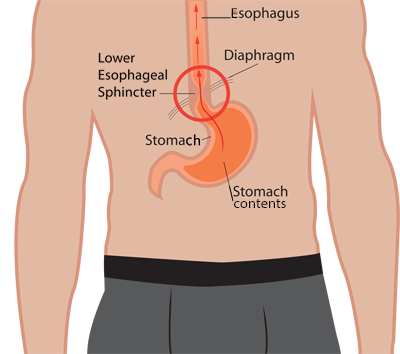Conditions: Reflux
Including gastroesophageal reflux disease (GERD) and laryngopharyngeal reflux (LPR)
WHAT IS REFLux?
Stomach juices are a caustic mix of acid and enzymes that break down food in preparation for digestion. The stomach lining has a way of protecting itself from this mixture. Normally, a muscular ring (the lower esophageal sphincter) separates the stomach from the esophagus, opening only to let food or liquid enter the stomach. When the lower esophageal sphincter is loose or ineffective, stomach contents can pass from the stomach to the esophagus. Pressure on the abdomen (from obesity or pregnancy) can also squeeze stomach contents through the lower esophageal sphincter. When these stomach juices make their way up the esophagus (gastroesophageal reflux) or up to the voice box and throat (laryngopharyngeal reflux), this harsh solution treats the surrounding tissue just like it would with food: it begins to break it down since there is no specialized protection against stomach contents in the tissues above the stomach. Good studies have proven that stomach contents continue all the way up to the nose, sinuses, and even up the Eustachian tubes to get to the ears! All this causes inflammation and irritation. Many people think of reflux as being the same as heartburn, but a burning sensation mid-chest is only one of several ways reflux can cause annoyance. Throat clearing, a gravely voice, a feeling of post-nasal drip, ear fluid or ear pressure problems, and sinus infections are all common consequences of reflux. Because reflux is so common, diagnosis is often made by doing a short experiment: presume that reflux exists, treat it with medicine and a good dietary regimen, and see if symptoms improve. When needed, however, there are more objective ways to test for reflux, such as a having thin wire with sensors put in the throat and esophagus for 24 hours. Reflux might also be visually seen during on a video x-ray study (barium swallow), and if it is seen, the patient has reflux; if it is not seen during that study, reflux may be happening even if not at that particular time.
The acidity of the stomach juices varies throughout the day, and many medications used to treat reflux will reduce the acidity. Even when the pH is closer to neutral, however, the gastric juices may still move up to the esophagus or higher. The digestive enzymes found in gastric secretions still remain somewhat active in more neutral pH settings, and can still cause symptoms. This is called non-acid reflux.
When stomach liquid goes up to the esophagus and no further, the condition is called gastroesophageal reflux (GERD). When the stomach liquid traverses the esophagus and goes to the throat (including the larynx and pharynx), it is called laryngopharyngeal reflux (LPR).
More than half of adults have some degree of reflux, but among these, symptoms may vary. Severity may range from mild to severe and frequency of symptoms may range from occasional to frequent.
WhAT are the symptoms of reflux?
Symptoms of reflux are variable from person to person and from time to time. They are also somewhat nonspecific, meaning the presence of one or more of the symptoms may be due to reflux but may be the result of a different condition or cause.
Symptoms may include one or more of the following:
Frequent throat clearing
Sensation of “post-nasal drip,” mucus or a foreign body or discomfort in the throat
Hoarse voice, commonly a gravelly voice upon awakening
Heartburn - a sensation of burning under the breastbone.
Regurgitation - Feeling liquid rise up the esophagus to the throat
A recurring sour or bitter taste in the mouth
Frequent dry cough
Eustacian tube dysfunction or fluid in the middle ear, especially among adults, is commonly due to reflux.
Chronic sinusitis may be predisposed by reflux.
Trouble swallowing
Tightness in your chest or upper abdomen. The pain may a person from sleep.
Nausea
Sore throat
• Animated video explaining causes of a phlegm sensation in the throat
• Animated video explaining causes and ways to evaluate a throat foreign body sensation
what is silent reflux?
Individual reflux events are not noted, but one or more of the longer-standing symptoms are present,
how is reflux diagnosed?
Reflux may be diagnosed on the basis of symptoms, and in many cases, minor symptoms or symptoms that respond well to reflux treatment, no further evaluation may be necessary. For more bothersome or persistent symptoms or when other medical conditions need to be ruled out, several methods to more definitively identify reflux exist, including temporarily treating for reflux and observing for response, clinical, identifying reflux by x-ray during swallowing (barium swallow study), having a thin tube in the esophagus monitoring pH or presence of fluid for 24 hours, and endoscopy, where a physician uses a scope to view the esophagus and possibly remove a tiny sample of the surface for further analysis.
Hiatal hernia is a condition in which some of the stomach has moved into the chest, above the diaphragm muscle. This renders the lower esophageal sphincter less effective in retaining contents in the stomach. Hiatal hernia is one common contributor to reflux.
what factors commonly promote reflux?
What is consumed: Certain foods promote reflux.
When it is consumed: Eating or drinking within an hour or two of going to bed promotes reflux.
How much is consumed: Large meals promote reflux.
Anatomy - Some anatomic factors such abdominal obesity, pregnancy, or a hiatal hernia promote reflux.
Physiology - Some conditions such as obstructive sleep apnea or delayed gastric emptying also promote reflux.
This page










